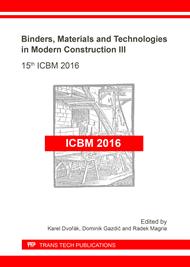p.63
p.71
p.76
p.83
p.88
p.94
p.100
p.106
p.111
The Assessment of High-Temperature Degraded Concrete Specimens of Different Mixtures by Acoustic Emission Method during Three-Point Bending Test and Pulse Velocity Method in Comparison with Destructive Tests
Abstract:
One of the advantages of concrete over other building materials is its inherent fire-resistive properties. The concrete structural components still must be able to withstand dead and live loads without collapse even though the rise in temperature causes a decrease in the strength and modulus of elasticity for concrete and steel reinforcement. In addition, fully developed fires cause expansion of structural components and the resulting stresses and strains must be resisted. This paper reports the results of measurements by Acoustic Emission method during three-point bending test on concrete specimens. The Acoustic emission method is a non-destructive technique used widely for structural health monitoring purposes of structures. The sensors are mounted by beeswax on the surface of the material or structure to record the motion of the surface under the elastic excitation of the cracking sources. The concrete specimens were heated in a programmable laboratory furnace at a heating rate of 5 °C/min. The specimens were loaded at six temperatures, 200 °C, 400 °C, 600 °C, 800 °C, 1000 °C, and 1200 °C maintained for 60 minutes. The results are obtained in the laboratory.
Info:
Periodical:
Pages:
88-93
Citation:
Online since:
October 2017
Authors:
Price:
Сopyright:
© 2017 Trans Tech Publications Ltd. All Rights Reserved
Share:
Citation:


